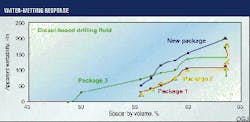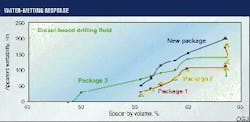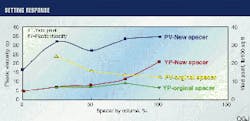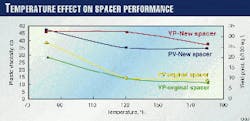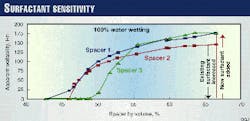A new technique used to evaluate apparent wettability has allowed Chevron Inc. to custom-design surfactant and spacer packages with 50% savings on costs and surfactant volumes.
To date, the technique, developed in an effort to remove subjectivity from the wettability evaluation process, has been successfully applied on several cement jobs in the Gulf of Mexico, South Texas, and Canada.
This conclusion of a two-part series (OGJ, Oct. 4, 1999, p. 71), examines diesel-based muds and explains how an innovative wettability-evaluation technology can provide experienced personnel with a valuable research tool, while allowing technicians in any moderately equipped field laboratory to customize surfactant packages.
South Texas
The wettability technique tested the performance of two surfactant packages commonly used to displace diesel-based drilling fluids in many South Texas wells. The first round of testing included a 12.6 ppg, diesel-based drilling fluid with surfactant packages mixed with 14 ppg aqueous spacers.
During initial tests, neither package fully water-wetted the test electrodes nor did they achieve a stable Winsor Type II emulsion (defined in Part 1). Additionally, the apparent-wettability meter showed conductivity levels one half the required level necessary for a 100% water-wetted state.
Both packages partially inverted the fluid phase but left a visible oil film on the surface of the electrodes. This lack of water-wetting capacity was further supported by an apparent-wettability reading of only 100 Hogans (Hn; Fig. 1). The fact that both packages obtained a maximum reading at 55% spacer volume, neither of which remaining stable under various temperature and shear conditions, indicated that the mixture had entered a Type III emulsion phase.
Package 1 achieved its full water-wetting capacity after adding 0.2 gal/bbl of another surfactant, while Package 2 became fully water-wet after increasing the amount of existing surfactant.
In both cases, however, severe solids settling occurred when the system reached 100% water-wetting capacity. At this point, Package 1 contained 2.55 gal of surfactant/bbl of spacer while Package 2 contained 1.2 gal/bbl.
Using this information, laboratory technicians formulated and evaluated Package 3, which included components from Packages 1 and 2, resulting in a total surfactant content of 1.3 gal/bbl. Package 3 inverted the drilling fluid at the lowest ratio, generated higher apparent wettability levels, yet still failed to water-wet fully the electrodes (100% meter reading).
In previous conventional tests applied to a 17 ppg diesel-based drilling fluid comprised of the same chemicals, Packages 1 and 3 performed well (Fig. 2). These results provide further evidence that the chemistry and required surfactant loadings can vary drastically, even between drilling fluids that share the same base system.
To further evaluate the wettability capacity of Package 3, technicians titrated the mixture of drilling fluid and Package 3 with additional surfactants to determine each surfactant's effect on wettability (Fig. 1). Next, based on the responses of everything observed so far, a new system was designed from scratch, using only two of the four components from the previous packages.
In an effort to eliminate the drill cutting and solids-settling problem, a different spacer with a higher yield point was used for the new system (Package 4). This package maintained full apparent wettability for a period of 5 min, ranging from static to high-shear conditions.
Designed with only 0.9 gal of surfactant/bbl of spacer, Package 4 contained less surfactant than either of the original packages while achieving 100% water wettability at a lower spacer-mud ratio (Fig. 1).
A cost analysis indicated that the new surfactant package would save the operator 59% in surfactants alone and would significantly increase the likelihood of successful zonal isolation.
Spacer compatibility
Although surfactants play a dominant role in determining water wettability during the displacement of drilling fluids, necessary to avoid undesirable viscosity levels, the spacer formulation should also be evaluated for drilling fluid compatibility (Figs. 3 and 4).
For example, an extremely viscous fluid can plug the annulus, drillpipe, and liner, while increasing the risk of formation breakdown during a job.
In contrast, a lack of viscosity-specifically a low yield point-can result in the separation of solids and fluids in the mixture as reported during the above-mentioned case. This condition created severe settling problems while testing a 10.8 ppg diesel mud, that if continued to go unnoticed, may have resulted in bridged tubulars, downhole tools, and annuli.
The risk for such problems becomes greatest in the narrow passages of liner laps or around liner-hanging tools and liner-top packers. And solids separation from the carrier fluid can allow barite and drill cuttings to lodge on the low side of the annulus in deviated wellbores. Once these deposits form, they become difficult, if not impossible, to remove.
High or low-viscosity anomalies should be noted for further evaluation. For example, most laboratories test standard mud-to-cement ratios of 25:75, 50:50, and 75:25 for compatibility purposes. Compatibility problems manifested by rheological spikes, however, have been shown during this project to occur at other ratios.
The apparent-wettability evaluation technique can allow the technician to detect compatibility problems at any mud-to-spacer ratio. Consequently, if a compatibility problem is indicated, the technician can perform testing at the specific volume ratio of concern, then adjust the surfactant package accordingly to rectify the problem while maintaining apparent wettability.
Blind verification
The various interactions between drilling fluids and spacer systems were further shown during the testing of a diesel-based drilling fluid in South Texas. Because the sample came from an unknown location, supplied by another drilling-fluid company, local knowledge of fluid composition could not be used to aid in the design of the new package, providing evidence that the technique can be used under any situation.
Using the previously designed Package 4 base surfactant system in Spacer 1, the technician achieved 100% apparent wettability. However, because conditions encountered viscosity incompatibility problems, the package proved problematic. A second package (Spacer 2), containing an additional surfactant, solved the compatibility problem, but the level of wettability was compromised (Fig. 5).
And when technicians titrated the second package with minute quantities of an existing component, its water-wetting capacity was lost altogether. Fortunately, the introduction of a fourth surfactant fully restored the system, illustrating the sensitivity of mud-spacer mixtures as the surfactant composition was adjusted.
Based on these lessons, technicians designed a third package (Spacer 3) that immediately passed all compatibility and apparent wettability tests. By allowing laboratory personnel to examine the exact effects of each surfactant, the new technology provided the necessary data for designing an effective surfactant package in about 3 hr.
Without this technology, such testing might have taken days to complete.
Aqueous spacers
Although the performance of nonaqueous or even solvent-based spacers has been debated by many cement experts, such approaches have been successfully used to remove drilling fluid before cement operations. Some documented studies, however, have raised questions about the risks involved with certain solvent systems.1
Because aqueous spacers can be premixed in one package, it then becomes possible to reduce equipment and personnel requirements for material preparation. Additionally, there are fewer fluids to test, the rheology at the fluid interfaces is better understood, and smaller fluid volumes are typically required.
Also, unlike jobs that use nonaqueous systems, on-site operations encounter fewer health, safety, environmental, and flash-point concerns with aqueous spacers.
While the design of aqueous spacers becomes more intricate in that an aqueous spacer must perform the work of two fluid groups, usually involved in nonaqueous and solvent-based spacer systems, the apparent-wettability technology greatly simplifies the design process.
Nonaqueous and solvent-based systems approach wettability with a two-step process. First, operators bump a spacer, which is highly compatible with the drilling fluid, against the mud. This fluid may simply include a volume of preflush composed of the base oil used to make the drilling fluid, or it may contain its own surfactants and solvents.
Some nonaqueous spacers use invert emulsion systems that are compatible with the drilling fluid, cement slurry, and any water-wetting spacers or preflushes.2
A second, aqueous-based spacer should be-but is not always-pumped to water-wet the wellbore surfaces. This spacer must be compatible with both the nonaqueous system, which is pumped ahead of the spacer, and the cement slurry, which is pumped behind.
Furthermore, because of unknown displacement efficiencies and subsequent intermixing, technicians advise that compatibility tests be conducted between the mud, cement slurry, and each of the spacer fluids. This extra testing, however, can complicate what is typically a much simpler situation when only the aqueous spacer is used.
The use of solvents for displacing nonaqueous mud systems also raises concerns regarding the recovery of drilling fluid and elastomer compatibility.
Drilling fluid recovery
The emulsifier packages of some invert drilling-fluid systems, especially synthetic systems, often become susceptible to permanent solvency. When this occurs, very high concentrations of additional emulsifiers may be needed to recover the drilling-fluid system, if possible.
While this may not significantly affect jobs in which the fluid remains in the annulus, the inability to recover the drilling fluid can economically hinder the success of a job, especially if fluid recovery becomes part of the well procedure.
Drilling-fluid suppliers have reported cases in which improperly designed solvent systems caused the disposal of entire drilling-fluid systems. Thus, for those jobs that require mixing recovered drilling fluids back into the working mud system, the solvent package must be carefully tested over a range of temperatures, helping to ensure that the drilling-fluid system will not be destroyed.
Elastomer compatibility
Solvent-based spacer incompatibility with the elastomers used by the suppliers of cementing tools and pumping services can result in job complications or failures.
Synthetic-based drilling muds also contain chemicals that can degrade elastomers.3 4 A recent study discusses in detail how low-molecular-weight terpene and limonene-based solvents effectively penetrate the structure of elastomers as effectively as esters (OGJ, Oct. 25, 1998, p. 75).
Incompatibility problems often result in the swelling, cracking, or other degradation of elastomers. To guard against such problems, all solvent-based or solvent-containing spacers should be tested for compatibility with the drilling mud at the appropriate temperature and pressure, before a job is initiated.
References
- Patel, A., Wilson, J.M., and Loughridge, B.W., "Impact of Synthetic-Based Drilling Fluids on Oilwell Cementing Operations," SPE paper 50726 presented at the SPE International Symposium on Oilfield Chemistry, Houston, Feb. 16-19, 1999.
- Halliburton Energy Services Inc., Cementing Technology Manual, Section 16.
- Kubena Jr., E., Ross, K.C., Pugh, T., and Huycke, J., "Performance Characteristics of Drilling Equipment Elastomers Evaluated in Various Drilling Fluids," SPE paper 21960 presented at the SPE/IADC Drilling Conference, Amsterdam, Mar. 11-14, 1991.
- Badrak, R.P., "Effects of New Generation Drilling Fluids on Drilling Equipment Elastomers," SPE paper 27452 presented at the SPE/IADC Drilling Conference, Dallas, Feb. 15-18, 1994.
The Author
Hal Grant is an advisor at the Chevron Drilling Technology Center (recently retired). His petroleum career spans 32 years with Chevron Inc. and 12 years with Halliburton Energy Services Inc. For most of his career, Grant specialized in cementing technology. He is past chairman of the API Committee 10 on Well Cements.
